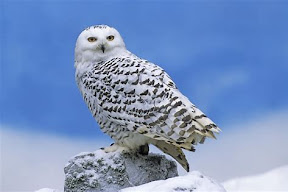Fast Facts: Snowy Owl
The Snowy Owl : Bubo scandiacus
Description: Being one of the most well-known owls on the planet, the Snowy Owl 's distinct white feathers patterned with black and brown make it stand out even in the snow-covered tundra. Males tend to have whiter overall while females have more pattering on their feathers. All Snowy Owls have especially thick feathers to protect them against the below freezing temperatures of the Arctic. With a wingspan of five feet and weight of 4 pounds, this adaptation also makes the Snowy Owl one of the largest and heaviest owls in the world.
Habitat: Preferring habitats with elevation, such as outcrops and knolls, Snowy Owls are mostly found in open tundra and coastal habitats. In contrast, their habitats also often include flat and even areas where Snowy Owl parents will set up breeding sites for their young. In many cases, a tidal flat will be used, which is a kind of coastal wetland.
Diet: Small mammals like lemmings, voles, and rodents make up the Snowy Owl's diet. These birds are purely carnivorous; they'll even prey on smaller birds. Lack of prey availability may sometimes lead Snowy Owls to prey on larger animals as well, like hares, racoons, and prairie dogs.
Behavior: Generally, Snowy Owls are solitary creatures when the breeding season is over. Unusually, these owls aren't nocturnal and are especially active during the summer days. These birds have a unique "sit and wait" hunting style where they catch prey on the ground or in the air; pursuit of prey is quite uncommon.
Conservation Status: Listed as Vulnerable, the population of Snowy Owls is around 100,000-200,000. But as high as this number may seem, there are only about 20,000 breeding pairs left. One of the main threats to the Snowy Owl is climate change. With temperatures on the rise, Snowy Owls face both habitat loss and a decrease in prey populations.
Unique Traits: Snowy Owls migrate like many other kinds of birds, but a Snowy Owl's migratory pattern is unpredictable and changes every year. Some Snowy Owls overwinter in Canada, the Northern US, Scandinavia, and Russia while others may stay in their Arctic breeding grounds all year. Because these migration patterns are so hard irregular, they are often associated with irruptions, season/periodic movement trends. Irruptions occur when a larger than expected number of birds migrate to Southern regions. When there's a lack of food or an overpopulated area, Snowy Owls migrate in the masses.
https://dualtourstep.live/?utm_campaign=INccHxHRWrew3TQsLBbfNnbGFYUZobMqxXT9Zrw5FhI1&t=main9
http://king-animal.blogspot.com/2012/08/snowy-owl.html
https://abcbirds.org/bird/snowy-owl/
Snowy Owl - Facts, Diet, Habitat & Pictures on Animalia.bio




Comments
Post a Comment